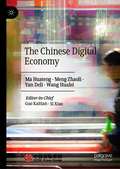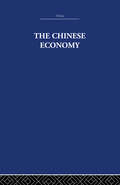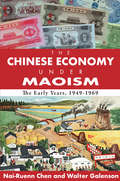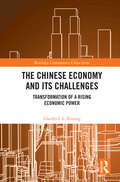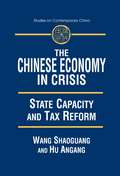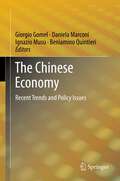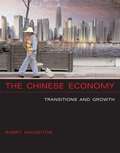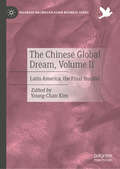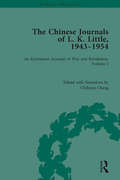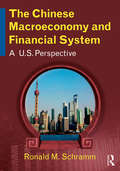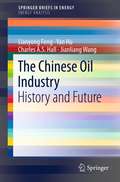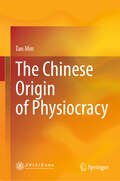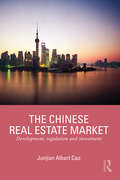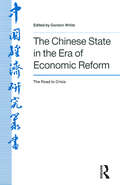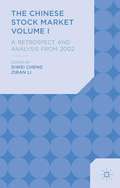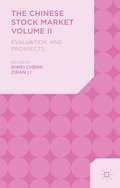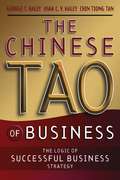- Table View
- List View
The Chinese Digital Economy
by Ma Huateng Meng Zhaoli Yan Deli Wang HualeiThis book points out that “Internet” is the means, and the digital economy is the result. Therefore, the development of digital economy will inevitably have a profound impact on traditional enterprises and Internet enterprises and become the main way and new driving force for China's innovation and growth.The book starts with the concept of digital economy and reveals the current development of digital economy, how to improve the foundation of digital construction, and the strategies for accelerating digital transformation of various industries, the problems that need to be solved in the development of digital economy and the huge role it will play in promoting society. The book provides a clear blueprint for the government and enterprises to understand and formulate policies and development strategies in the era of digital economy.
The Chinese Economy
by Solomon AdlerFirst published in 1957.This volume provides a broad survey of economic progress in China from 1949 to 1952 and covers the historical background, China's economic system, industralisation and planning, the first Five Year Plan in industry, agriculture, transport, commerce and finance, education and health and foreign trade. The work is supplemented with an extensive bibliography, maps and statistical tables.
The Chinese Economy Under Maoism: The Early Years, 1949-1969
by Andrew M. GreeleyOver sixty years have elapsed since the Communists gained control of the Chinese mainland. The years between 1949 and 1969 were a time of constant change and periodic cataclysm-the initial purges, the Great Leap Forward, and the Cultural Revolution-all bound up with the Communist conception of how to move the country into modernity in the shortest possible time. The Chinese Economy under Maoism summarizes and evaluates the economic consequences of the Communist path to development in a concise, factual presentation that can be readily comprehended by non-economists. The authors review the major features of the Chinese economy prior to the Communist takeover and discuss the policies, performance, and problems of the individual sectors of the Chinese economy during its initial years under Communism. Included in their review are industry, agriculture, foreign trade, resource allocation, population, employment, and living standards. A concluding chapter summarizes Chinese economic growth and presents a discussion of future policy alternatives and an optimum economic policy for China. Based on important findings of Western scholars, with many original interpretations by the authors, this material is presented from a developmental point of view. Since it was originally published in 1972, sections of the book devoted to comparative studies of progress in India and the former Soviet regime will be of particular interest now. Free of technical language and providing insights into the economy of one of the most important countries in the world, this book will be useful not only to economists but to a broad range of sinologists, political scientists, sociologists, and historians interested in the path of revolution.
The Chinese Economy after WTO Accession (The Chinese Trade and Industry Series)
by Shuanglin LinThis book provides an analysis of the Chinese economy in the context of globalization after China's admission to the WTO. In four parts it addresses globalization, privatization, fiscal policy and financial development. In depth analysis is also given to international trade, industrial development as well as economic performance and the labour market. The Chinese Economy after WTO Accession is a comprehensive study supported by recent data and quantitative analysis. It provides a solid basis for better understanding the possible future directions of China's economy. This volume is an indispensable source for scholars and students alike.
The Chinese Economy and its Challenges: Transformation of a Rising Economic Power (Routledge Contemporary China Series)
by Charles C.L. KwongThe remarkable transformation of the Chinese economy in terms of its structure and growth has drawn unprecedented attention from academics, policy makers and businessmen alike. In the past four decades, China swiftly transformed from a centrally-planned to a market-oriented economy, with an economic size just behind the US and ahead of Japan. Amid commendations for China's economic success offering valuable reform and growth lessons to other developing countries, underlying challenges have been emerging, which constitute long-term risks in shaking China's sustainable success. These challenges encompass a wide range of sectors and issues such as the rural-urban divide, state monopoly, policy loans in the banking sector, lack of skilled and sophisticated workers, environmental degradation, etc. This book unveils the risks and challenges embedded in China's spectacular economic success and demonstrates that effective handling of these challenges is vital for China to avoid falling into the "middle-income trap". It is elucidated that feasible solutions are available to accommodate these risks and the clue of success lies on the willingness and ability of China's central leaders to implement further reforms. This book is a valuable reference for undergraduate and postgraduate students, academics, and public and business policy makers who are concerned about the current status and future development of the Chinese economy.
The Chinese Economy in Crisis: State Capacity and Tax Reform (Studies On Contemporary China)
by Xiaohu (Shawn) Wang An'gang HuThe authors of this work argue strongly that the decentralization that has taken place in China over the past two decades threatens to undermine the future of reform and perhaps even the state itself. They contend that reform has undermined state capacity in China, and that the state's fiscal revenues, as a percentage of GNP, have declined and will continue to decline into the foreseeable future, thereby weakening China's ability to mobilize resources for modernization.
The Chinese Economy, second edition: Adaptation and Growth (The\mit Press Ser.)
by Barry J. NaughtonThe new edition of a comprehensive overview of the modern Chinese economy, revised to reflect the end of the “miracle growth” period.This comprehensive overview of the modern Chinese economy by a noted expert on China's economic development offers a quality and breadth of coverage not found in any other English-language text. In The Chinese Economy, Barry Naughton provides both a broadly focused introduction to China's economy since 1949 and original insights based on his own extensive research. This second edition has been thoroughly revised to reflect a decade of developments in China's economy, notably the end of the period of “miracle growth” and the multiple transitions it now confronts—demographic, technological, macroeconomic, and institutional. Coverage of macroeconomic and financial policy has been significantly expanded.After covering endowments, legacies, economic systems, and general issues of economic structure, labor, and living standards, the book examines specific economic sectors, including agriculture, industry, technology, and foreign trade and investment. It then treats financial, macroeconomic, and environmental issues. The book covers such topics as patterns of growth and development, including population growth and the one-child family policy; the rural and urban economies, including rural industrialization and urban technological development; incoming and outgoing foreign investment; and environmental quality and the sustainability of growth.The book will be an essential resource for students, teachers, scholars, business practitioners, and policymakers. It is suitable for classroom use for undergraduate or graduate courses.
The Chinese Economy: Recent Trends and Policy Issues
by Giorgio Gomel Ignazio Musu Daniela Marconi Beniamino QuintieriThis book takes readers on a unique journey across some of the most debated implications of the rise of the Chinese economy on the global scene. From the analysis, suggestions emerge on how to improve statistical tools to measure performance and to obtain more precise macroeconomic forecasts. Moreover, it confirms the suspicion that a governance model of firms that does not sufficiently encourage market competition may have significant costs in terms of efficiency for the Chinese production system. The analysis of demographic factors and of household savings gives further support to calls for a serious reform effort, particularly of the pension and health care systems, to utilize households' savings more efficiently and equitably. Finally the analyses of Chinese and global trade underscore the need for a less superficial consideration of the implications of the Chinese presence in global markets.
The Chinese Economy: Transitions and Growth
by Barry NaughtonThis comprehensive overview of the modern Chinese economy by a noted expert on China's economic development offers a quality and breadth of coverage not found in any other English-language text. In The Chinese Economy, Barry Naughton provides both an engaging, broadly focused introduction to China's economy since 1949 and original insights based on his own extensive research. The book will be an essential resource for students, teachers, scholars, business people, and policymakers. It is suitable for classroom use for undergraduate or graduate courses. After presenting background material on the pre-1949 economy and the industrialization, reform, and market transition that have taken place since, the book examines different aspects of the modern Chinese economy. It analyzes patterns of growth and development, including population growth and the one-child family policy; the rural economy, including agriculture and rural industrialization; industrial and technological development in urban areas; international trade and foreign investment; macroeconomic trends and cycles and the financial system; and the largely unaddressed problems of environmental quality and the sustainability of growth. The text is notable also for placing China's economy in interesting comparative contexts, discussing it in relation to other transitional or developing economies and to such advanced industrial countries as the U.S. and Japan. It provides both a broad historical and macro perspective as well as a focused examination of the actual workings of China's complex and dynamic economic development. Interest in the Chinese economy will only grow as China becomes an increasingly important player on the world's stage. This book will be the standard reference for understanding and teaching about the next economic superpower.
The Chinese Global Dream, Volume I: Latin America, the Final Hurdle? (Palgrave Macmillan Asian Business Series)
by Young-Chan KimThis book explores the socio-economic, political and diplomatic implications of China’s ongoing engagement with the Latin America region against the backdrop of an increasingly fragile global political climate. It investigates the successes of the post-pandemic era diplomacy, alongside the setbacks, as China seeks to secure and maintain her presence across the region. Ever since Xi lengthened his stewardship of China by another decade, he has been aiming to level-up the Chinese values and Sino-orientalism on the global stage. Through the Belt and Road Initiative (BRI) he expanded into the Middle East, and through natural resource veiled humanitarian relief efforts, he sought to strengthen China’s hold across Africa. Only Latin America now remains. This book investigates the tentative shift in bilateral and multilateral relations, along with the possibility and likelihood of a stronger China-Latin America alliance, and the reactions of the West. The book endeavours to combine traditional academic discourse with contemporary interpretations and provides a balanced assessment of the current successes and drawbacks of the network. Making a comparative analysis of the roles of each of the Latin American nations in allowing China to fulfil this endeavour through a global vs. local approach, this book is suitable for those researching and studying contemporary Chinese strategic relations, regional studies and geo-strategy.
The Chinese Global Dream, Volume II: Latin America, the Final Hurdle? (Palgrave Macmillan Asian Business Series)
by Young-Chan KimThis book explores the socio-economic, political and diplomatic implications of China’s ongoing engagement with the Latin America region against the backdrop of an increasingly fragile global political climate. It investigates the successes of the post-pandemic era diplomacy, alongside the setbacks, as China seeks to secure and maintain her presence across the region. Ever since Xi lengthened his stewardship of China by another decade, he has been aiming to level-up the Chinese values and Sino-orientalism on the global stage. Through the Belt and Road Initiative (BRI) he expanded into the Middle East, and through natural resource veiled humanitarian relief efforts, he sought to strengthen China’s hold across Africa. Only Latin America now remains. This book investigates the tentative shift in bilateral and multilateral relations, along with the possibility and likelihood of a stronger China-Latin America alliance, and the reactions of the West. The book endeavours to combine traditional academic discourse with contemporary interpretations and provides a balanced assessment of the current successes and drawbacks of the network. Making a comparative analysis of the roles of each of the Latin American nations in allowing China to fulfil this endeavour through a global vs. local approach, this book is suitable for those researching and studying contemporary Chinese strategic relations, regional studies and geo-strategy.
The Chinese Journals of L.K. Little, 1943–54: An Eyewitness Account of War and Revolution, Volume I (The Making of Modern China)
by Chihyun ChangLester Knox Little kept a detailed journal of his time in China and Taiwan. Covering the years 1943 to 1954 it provides important new insights about some of the most dramatic episodes in China’s mid-twentieth century history: Sino-Japanese military and economic competition, China’s domestic political struggle between the Nationalist Party (Kuomintang) and the Chinese Communist Party, and the post-war/Cold War balance of power in Southeast and East Asia. It also contains rich first-hand materials for understanding conditions in Chongqing and post-war Shanghai, the last years of the Republic of China on the Chinese mainland and its early years in Taiwan, and a new inner history of his beloved Chinese Maritime Customs Service. Little’s account, with his insightful comments and explicit descriptions, provides us with a continuous record from the viewpoint of a capable American citizen in Chinese employ who felt responsible for his Chinese and foreign colleagues and for the modernisation of ‘Free China’, as well as allowing a unique insight into the heart of government during a time of intense social and political change. In addition to the original texts, this edition includes extensive explanatory notes providing detailed contextual information regarding the people and places mentioned.
The Chinese Macroeconomy and Financial System
by Ronald M SchrammThis new textbook on the Chinese economy clearly presents all that the world's second largest economy has accomplished, as well as what work remains to be done. As economic development in China for the last 30 years has been mostly "top down," this text focuses on the macroeconomic and monetary sides of the economy. Utilising case studies throughout, the book uses not only the traditional macroeconomics tools in explaining the Chinese economy, but also takes a novel approach by assessing China as a company. Through employment of models from finance, such as cash flows and valuations, the text is able to dig deeper into understanding the fundamental characteristics of the Chinese economy. The book also presents extremely useful analysis of the comparisons and contrasts between Chinese economic activity and that of the U.S. economy. eResources including chapter questions with solutions and lecture slides will be available on this webpage.
The Chinese Mind: Understanding Traditional Chinese Beliefs and Their Influence on Contemporary Culture
by Boye Lafayette De MenteThe Chinese: understanding a people and their culture through key words and language.The Chinese Mind pinpoints areas of China's traditional values and behaviors that play a significant role in the business and social relationships of the Chinese.<P><P> It also identifies key areas of Chinese culture that have changed as a result of the adoption of a market-based economy and other elements of Western culture. It includes discussion topics and questions, along with an extensive selection of Chinese "code words" that explain the essence and role of key elements of the traditional culture that have survived into modern times. Covering everything from the importance of Confucius, the great Chinese philosopher, to the influence of foreign fast food and video games, this book provides a wide-ranging glimpse into the seemingly opaque Chinese mind.The Chinese Mind is an excellent overview of Chinese tradition, history, and culture that is perfect for the classroom, tourists or outsiders living or doing business in China. Some of the vital concepts explored here include:Yin and Yang, the search for balance in all thingsMianji, the importance of faceHong, looking at things holisticallyDe, the power of virtueGuo cui, the national essence of the ChineseZhong fu, the pursuit of insight
The Chinese Model of Modern Development (Routledge Studies on the Chinese Economy #Vol. 17)
by Tian Yu CaoThis study examines the Chinese model of modern development, reflecting on the historical experience of China's reform and highlighting theoretical issues that are crucial for understanding the reform in its historical and global contexts. Bringing together articles from scholars, including designers of and active participants in the reform, opinion setters in the current debates on the nature and future of the reform, and Western scholars whose ideas have had great impact on Chinese intellectuals, the book considers the goals of China's reforms and the ways in which these goals may be achieved, the most urgent issues now facing China, and globalization and its impact on China.
The Chinese Oil Industry
by Charles A. Hall Lianyong Feng Jianliang Wang Yan HuThe Chinese Oil Industry: History and Future presents a wealth of tables and figures with new data on Chinese fossil fuel production and consumption, together with a peak oil model to forecast future trends in energy supply and demand. Energy experts in China and the United States provide you with a unique overview of the entire Chinese oil industry. The authors discuss trends in production and consumption of global significance through to the middle of the 21st century, including the energy returned on energy invested (EROI) for China's oil and gas. The role of oil in the industrialization of China is described as are four phases in the history of the Chinese oil industry. Detailed coverage of resources and exploration, pipeline development, refining and marketing, petroleum and natural gas pricing policies, and international cooperation is followed by consideration of conservation, renewable energy, and environmental impact. The authors also address the importance of coal and the probable future of coal production. - Offers a comprehensive view of the Chinese oil industry - Presents new and previously unpublished data - Covers history and future trends in production and consumption - Introduces a new peak oil model for China - Discusses EROI trend of oil and natural gas and its consequences for the Chinese economy - Written from an objective viewpoint by leading energy experts
The Chinese Origin of Physiocracy
by Tan MinThis book, by way of a comparative analysis of the main economic viewpoints of the Chinese and Western traditions, shows that the theories of the Physiocrats originated, in a significant way, from ancient Chinese economic thought. Resorting to a large number of relevant Chinese and foreign materials, the author argues convincingly for the great role ancient Chinese thought played in the birth of Western modern economics. The book is funded and published by the Shanghai Marxist Academic Publications Foundation. It systematically and convincingly demonstrates the Physiocrats’ basic economic views and their origins in ancient Chinese thought. This is a very innovative, unique and exciting research. Many scholars in China have regarded the work as a breakthrough in the study of the history of economics, because of which the author has won the second prize of outstanding achievement in Shanghai’s philosophy and social sciences.
The Chinese Path Toward a Leaner Government
by Yining Li Zhiqiang ChengThis book focuses on the administration streamlining aligned with the market-oriented reform process in China. The book is divided into two parts. The first part clarifies why administration is necessary and important, what it covers, and how to deal with the relation between the central and the local governments. The second part presents empirical analysis in specific areas, including agricultural reform, fiscal reform, government reform and education reform, and a series of decentralization reforms. This book is a collective wisdom from Peking University and is edited by Chinese economist Yining Li.
The Chinese Path to Economic Dual Transformation (China Perspectives)
by Li YiningEconomic transformation in traditional development economics refers to the transition from an agricultural society to an industrial one. Based on the practical conditions and the experience since reform and opening up in the late 1970s, the author observes that the path China's economy takes is a dual transformation, namely, developmental transformation from an agricultural society to an industrial economy, and institutional transformation from planned economy to market economy. Centering on property ownership reform which is the supreme reform of the dual transformation, this book discusses land ownership approval, stock-holding system reform and the maintaining ownership of private enterprises, etc. Besides, the book expounds on the urbanization in China, believing that it is not only the outcome of the dual transformation but also the booster that will help China's economy continue to develop at a high speed. Independent innovation and industrial upgrading which is the key to the enhancement of enterprises' competitiveness is also covered. The combination or overlapping of the two types of transformations in China has had no precedent in history, and it has not been discussed in traditional development economics. Scholars and students in China's economic studies and development economics studies will be attracted by this book. In addition, this book will be a valuable reference for other developing countries which are undergoing economic transformation.
The Chinese Real Estate Market: Development, Regulation and Investment (Routledge International Real Estate Markets Series)
by Junjian Albert CaoThis is the first book to fully present, analyse and interpret the Chinese real estate market. Dr Junjian Albert Cao examines the Chinese real estate market’s growth trajectory, unique governance and factors affecting values and investment in the context of reforms, rapid economic growth and urbanization. The book provides essential insights into the institutional change surrounding the development of the property market, government intervention at local and national levels, taxes and other regulatory charges, and factors such as market practices, economic changes, government policies and social changes that affect the value of real estate. Furthermore, the book analyses academic and policy debates on issues such as: commercial property investment housing price inflation property rights protection affordable and social housing market practices and regulation environment and sustainability taxation property-led growth and the reliance of local economic growth on the property sector The book offers a comprehensive, in-depth and up-to-date account of the Chinese property market and presents a full assessment of the investment potential of Chinese real estate. It is a must read for students, academics and real estate professionals interested in this fascinating real estate market that has implications for Chinese and the world economies.
The Chinese Sharing Economy: New Economy Program for Supply-Side Reform
by Ma Huateng Zhang Xiaorong Sun Yi Cai XiongshanThis book explores the social and economic impact of the sharing economy- of taxis, apartments, and other goods and services- in China, and how the sharing economy can allow for supply-side economic reform. The sharing economy is in the ascendant in China, and significant achievements have been made in innovation in leasing, travel and other fields. This book predicts that this economic tide, which has affected hundreds of millions of people, will inject a powerful new momentum into China's economic growth, help China's economy achieve "power conversion" and turn the service industry into the "main engine" of economic growth. This book will interest China watchers, economists, and scholars of the technology sector.
The Chinese State in the Era of Economic Reform: Asia and the Pacific (Studies On The Chinese Economy Ser.)
by Jay D WhitePresents ten tales featuring Lord Bau, a wise judge who was a champion of righteousness and protector of the weak against the powerful.
The Chinese Stock Market Volume I
by Siwei Cheng Ziran LiBoth quantitative and qualitative analysis is used to review China's stock market in a book containing the latest research on China's IPO market, the 2006-07 market bubble, the development of institutional investors, the stock index futures market, stock sector performance, corporate governance of listed firms and China's growth enterprise market.
The Chinese Stock Market Volume Ii
by Siwei Cheng Ziran LiBoth quantitative and qualitative analysis is used to review China's stock market in a book containing the latest research on China's IPO market, the 2006-07 market bubble, the development of institutional investors, the stock index futures market, stock sector performance, corporate governance of listed firms and China's growth enterprise market.
The Chinese Tao of Business
by Usha C. Haley George T. Haley Chinhwee TanHow can managers discover, develop and implement successful business strategies for China and our global economy? Drawing on in-depth research with top executives of successful Chinese and Western companies, this book provides a road map for profitable business strategies in our interconnected economy. In the process, the authors describe and examine both Chinese and Western strategic management, their weaknesses and strengths. Starting with an analysis of the historical, cultural and legal antecedents of Chinese strategy, the authors identify potential for synergy and dominance between companies from Western, industrialized economies and Chinese companies. The book closes with recommendations on how the managements of non-Chinese companies, now pouring into China, can most effectively compete and interact with Chinese businesspersons and governments.The Chinese Tao of Business offers guidance to compete successfully against local companies and in foreign markets through:Unique insights into Chinese bus iness strategy, including its origins and influencing factors;Insightful perspectives on the evolution of China's market and business environments;Incisive analysis of Eastern and Western strategic decision-making styles and how they differ;Cogent identification of hidden and overt threats, pitfalls and opportunities that Western companies face in China and how to plan for them;Effective direction through an Adaptive-Action Road Map (ARM) for successful business strategies in China and the global economy.
